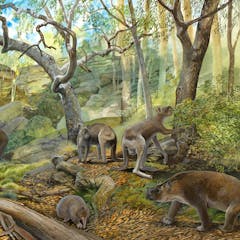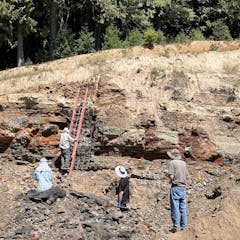
Articles on Fossils
Displaying 1 - 20 of 386 articles

Ichthyosaurs were the last giant reptiles to rule our oceans.

The scarcity of bat fossils is more than a palaeontological puzzle: it has implications for bat conservation strategies today.

Some extinct kangaroos may barely have hopped at all.

The origin date for flowers is a source of debate among scientists – but a new approach may help bring clarity to the question.

Calcite, the material making up fossilized eggshells, may preserve amino acids better than bone.

By examining fossilized bone tissue, a new study finds rapid growth was an asset for survivors of the Great Dying 250 million years ago, Earth’s largest mass extinction event.

Horse fossils are abundant and widespread across North America. Scientists often use their long history to illustrate how species evolve in response to a changing environment.

Oceanic dispersal of dinosaurs between Europe and Africa shows how low-probability, high-impact events drive evolution.

If you love learning about dinosaurs don’t let crowdpleasers like the T Rex distract you from the fascinating birdlife that once roamed the Earth.

If the climate warms by more than 7 degrees, the likelihood of extinction for a species increases, regardless of its other traits.

Some of these giant vegetarians were as tall as a 3-story building. Microscopic analysis of their teeth, bones and eggshells reveals how they grew, what they ate and even their body temperature.

Millions of years ago, widespread volcano eruptions in eastern Australia buried entire forests. Today, these time capsules reveal stunningly fossilised plants.

A lizard fossil that was thought to be the best preserved ever has turned out to have fake skin.

Fossils suggest that as many as three abelisaurid species coexisted in Morocco around 66 million years ago.

For decades, the sandstone in central Australia yielded tantalising segments of some sort of fossil fish. Now, we have finally pieced together a complete picture of this remarkable species.

The Isle of Skye has a rich palaeontological heritage, so perhaps it’s no surprise scientists made an important discovery there.

While NASA rovers on the surface of Mars look for hints of life, researchers back on Earth are studying ‘echoes of life’ from ancient basins – hoping that the two sites might be similar.

What paleontologists had believed to be spiny fins turned out to be elongated jaws. New examination of fossils that were 365 million years old revealed a fish with a remarkable lower jaw.

Fossil traces of the oldest complex ecosystems are found in precious few locations worldwide, including Australia. Newly dated fossils from Wales now join the ranks.

What happened to the three-metre tall apes that once lived alongside orangutans? A new study suggests they were too slow to adapt to a changing world.





